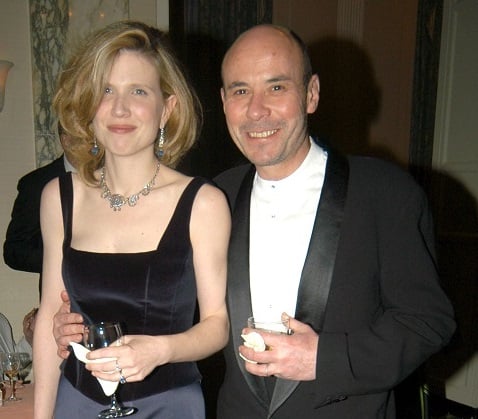Art World
5 of the Most Notorious Art Thieves, Swindlers, and Forgers of the 21st Century—and How They Were Finally Caught
These scammers of the art world concocted elaborate ruses that read like fiction, but all are true.

These scammers of the art world concocted elaborate ruses that read like fiction, but all are true.

Katie White

“It seemed like a nice neighborhood to have bad habits in,” wrote Raymond Chandler in the classic detective novel The Big Sleep. Chandler wasn’t talking about the art world specifically, but the sentiment captures some of its well-heeled, occasionally unscrupulous dealings.
Right now now, there’s the mounting world-wide search for art dealer Inigo Philbrick, whose laundry list of alleged crimes include selling a work he didn’t own to multiple collectors, holding $14 million dollars of art hostage, and then seeming to disappear. But that’s nothing new under the crooked sun of art scamming. As we kick off the roaring 2020s we thought we’d round up the other leading stories of shady dealers, forgers, and thieves from the past two decades.

Stéphane Breitwieser in 2006. Photo by Jef-Infojef via Wikimedia Commons.
The Scam: This notorious Frenchman stole at least 239 works from 172 museums throughout Europe between 1995 to 2001. Consistency was his skill: Supposedly he robbed an artwork every 15 days or so, often with the help of his former girlfriend Anne-Catherine Kleinklauss, who would stand as lookout as he removed paintings from their frames. What makes Breitwieser so intriguing is that his thieving lacked any financial necessity. Instead, he saw himself as something of a connoisseur, with a taste especially for 16th- and 17th-century works. His most expensive pinched painting was Lucas Cranach the Elder’s Sybille, Princess of Cleves, which was estimated to be valued at £5-£5.6 million.
How He Got Caught: He couldn’t quit while he was ahead. In November of 2001, Breitwieser filched a 16th-century bugle, of which only three are known to exist, from the Richard Wagner Museum in Lucerne, but a guard spotted him before he escaped. Seemingly insatiable, Breitwieser returned to the museum just two days later. A journalist named Erich Eisner happened to be walking his dog by the museum and, when he noticed a man who seemed out of place, surveying the museum, he alerted the very same guard who had spied Breitwieser a few days before. He was arrested in Switzerland, but it took authorities several weeks to get a search warrant for his home in France and in that time the thief’s spooked mother apparently destroyed a number of works, for which she was ultimately served just over 2 years in prison.
Where He Is Now: Breitweiser would wind up spending two years in prison Switzerland before being extradited to France, where in 2005 he would be sentenced to an additional three years by a court in Strasbourg. After he was released he wrote an autobiography of his exploits called Confessions of an Art Thief. But even that publishing success couldn’t satisfy his thirst for theft and in 2011, police discovered 30 stolen works in his home, landing him in prison for three more years. And just this past February he was arrested once again, this time in relation to a 19th-century paperweight he tried to sell on eBay.

Anna Sorokin, aka Anna Delvey, in a courtroom during her trial in New York. Photo by Timothy A. Clary/AFP/Getty Images.
The Scam: Here’s the takeaway: the ethos of “fake it till you make it” can go desperately wrong. The Russian-born Anna Sorokin decided she wanted a taste of the good life and arrived in New York a few years back a new woman—really. She adopted the persona of Anna Delvey, an imaginary German heiress with a fortune of €60 million, and set about splurging on luxury hotels, lavish meals, and whirlwind vacations to the tune of $200,000. But like any good make-believe trust-funder, she also had her pulse on the cultural scene and her agenda included setting up the so-called Anna Delvey Foundation, a “members-only” arts club on Park Avenue, for which she was in the ill-fated process of securing loans when she was arrested.
How She Got Caught: Delvey made a number of missteps that eventually caught up with her, including changing her place of birth on official documents, spending too flagrantly, and crossing a former friend who ultimately participated in an NYPD sting. After a dramatic 22-day court trial—in which Delvey’s lawyer likened his “moxie”-filled client to Frank Sinatra—an unrepentant Delvey, who seemed almost concerned about her wardrobe, was convicted on a total of eight counts, including grand larceny in the first, second, and third degrees, and theft of services. She was sentenced to four to 12 years in prison by the New York State Supreme Court—a comparatively harsh punishment compared to some other swindlers. She was also ordered to pay $198,956 in restitution and $24,000 in fines.
Where She Is Now: Delvey is serving time on Rikers Island and will eventually be moved to a prison in upstate New York. Her story will soon be coming to a television near you in the form of Inventing Anna, a forthcoming Netflix series about the infamous Soho grifter, played by Julia Garner. And maybe life in prison isn’t all bad—Page 6 reports she’s found love behind bars.

Glafira Rosales (center) leaves Manhattan Federal Court in 2013. Photo by: Jefferson Siegel/NY Daily News via Getty Images.
The Scam: It was thepièce de résistance of art scams. In the mid-1990s, Long Island art dealer Glafira Rosales approached New York City’s Knoedler Gallery with a trove of “masterpieces” by the likes of Jackson Pollock and Mark Rothko, which she claimed were consigned by a secret collector called, ahem, “Mr. X.” Somehow, these dubious works wound up being sold for tens of millions of dollars and into a number of prestigious collections between 1994 and 2009. A phony Rothko painting was even purchased by Domenico De Sole, a Sotheby’s board member who said he’d had no reason to doubt “the most trusted, oldest, most important gallery” at the time. Ann Freedman, the former director of Knoedler Gallery, has long maintained her innocence in the scam, despite overlooking even the most egregious of cautionary measures—which many of Knoedler’s victims say they find unlikely.
How She Got Caught: The mystery collection seemed to keep growing in scope. In 2011, amid financial troubles, the gallery, which had opened in 1846, shuttered its doors and the house of cards began to tumble. In late 2011, the New York Times published a story about a lawsuit filed against the gallery by collector Pierre Lagrange who believed he’d been duped into purchasing a fake Pollock. As the story unfolded it was eventually discovered that Rosales’s boyfriend Jose Carlos Bergantiños Diaz and his brother had hired Queens-based Chinese painter Pei-Shen Qia to create the myriad “mid-century” works, and in a very public trial In 2013, Rosales ultimately plead guilty to wire fraud, tax evasion, and money laundering.
Where She Is Now: Only Rosales received any punishment, serving three months in prison, and house arrest in 2017. She was also ordered to pay $81 million dollars to the victims. The Diaz brothers fled to Spain, where their extradition has not been granted. Qia, who was paid comparatively meagerly for his forgeries, fled to China where he claims not to know his works were being sold as originals. Freedman remains a free woman.

From left: Registrar Mathew Leininger, directors Jennifer Grausman and Sam Cullman, forger Mark Landis and co-director and editor Mark Becker from “Art and Craft” at the Tribeca Film Festival. Photo by Larry Busacca/Getty Images.
The Scam: A priest, a philanthropist, and an art forger walk into a museum and… well, they’re all the same person. This oddball case tells the story of a man who just wanted to see his art in museums and didn’t care whose name was on it. For decades, Mark Landis went about donating his fakes to museums under various names, and sometimes disguised himself as a faux Jesuit priest named Father Arthur Scott. Landis had trained at the Art Institute of Chicago, then attempted to open a gallery, but meeting with financial woes, and on the verge of moving back to Mississippi, he wanted to try to do one remarkable thing. His thinking? He painted a version of a Maynard Dixon work and donated it to a California museum as an original. Meeting with success, he continued to donate his own paintings to many smaller museums for 30 years, posing as artists as famed as René Magritte to many smaller, more obscure artists. His most remarkable skill as a forger was not his meticulousness, so much as his ability to work very quickly and in a number of styles.
How He Got Caught: A museum registrar by the name Mathew Leininger ultimately began to unravel the ruse in 2007, when he double checked documentation on a Paul Signac painting that had been donated to the Oklahoma City Museum of Art, only to find that identical works had been donated to several other museums by Landis (under his various aliases). In 2010, exposes followed in the Art Newspaper and the Financial Times and the jig was up (except not really!).
Where He Is Now: Donating works, even phony ones, to museums without any financial incentive, it turns out, is not against the law—so Landis never actually saw any consequences for his deceptions — though the costs of his donations to museums cost something to the tune of $5 million. In 2014, Art and Craft, a documentary about his life, came out, and museums have made an effort to expose his works. That said, Landis seems undeterred and has attempted to donate dozens more forgeries even after his story was exposed.

Larry Salander and his ex-wife Julie. Photo: Patrick McMullan.
The Scam: Call this a case of how the mighty have fallen. In 2003, Salander-O’Reilly Galleries was named the best gallery in the world by the Robb Report. By 2007, Earl Davis, son of the artist Stuart Davis and a friend of Salander, made the heartbreaking discovery that his friend had stolen and covertly sold 90 works by his father, leaving the younger Davis financially destroyed. Davis wasn’t the only one swindled by Salander, who had a taste for bigwig victims and bilked the like of tennis champion John McEnroe and Rober De Niro, Jr.
How He Got Caught: Salander’s Ponzi schemes began to collapse on each other. In the spring of 2009, he was charged with 13 counts of first-degree grand larceny, 10 counts of second-degree grand larceny, among a slew of other charges. A year later, in March 2010, he pleaded guilty to 29 felony counts of grand larceny and admitted to selling numerous artworks without permission after falling behind on the $154,000-a-month rent of the gallery’s 71 Street Space.
Where He Is Now: Salander was sentenced to six to 18 years in prison and is currently serving that sentence on Rikers Island.